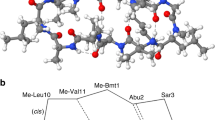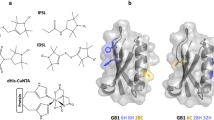Abstract
X-Band pulsed electron–electron double resonance (PELDOR) spectroscopy was used to investigate for the first time the magnetic dipole–dipole interaction between spin labels for frozen glassy methanol solutions at 77 K of double spin-labeled, medium-length peptaibiotics, namely, tylopeptin B and heptaibin. This study was conducted on tylopeptin labeled at positions 3 and 13 (T313) and heptaibin labeled at positions 2 and 14 (H214). PELDOR data analysis was carried out using the theory developed for short inter-spin distances. The distance distribution functions between spin labels for T313 (maximum at 1.76 nm, half-width of 0.07 nm) and H214 (maximum at 2.30 nm, half-width of 0.065 nm) were determined. It is found that the distance distribution function for peptide T313 has the Gaussian shape. The main part of the distance spectrum for H214 has Gaussian shape and additional less intensive broad lines are shifted to high distances range 2.5–3.5 nm. The upper limit of distance spectrum in this case corresponds approximately to the length of extended peptide molecule and the number of such configurations is low. Intramolecular distances between the labels at maxima observed allowed us to assign α-helical conformation to T313 and 310-helical structure to H214 in methanol solution.








Similar content being viewed by others
References
Yu.D. Tsvetkov, A.D. Milov, A.G. Maryasov, Russ. Chem. Rev. 77, 487 (2008)
A.D. Milov, R.I. Samoilova, Yu.D. Tsvetkov, F. Formaggio, C. Toniolo, J. Raap, J. Amer. Chem. Soc. 129, 9260 (2007)
A.D. Milov, Yu.D. Tsvetkov, F. Formaggio, S. Oancea, C. Toniolo, J. Raap, Phys. Chem. Chem. Phys. 6, 3596 (2004)
A.D. Milov, R.I. Samoilova, Yu.D. Tsvetkov, M. Jost, C. Peggion, F. Formaggio, C. Toniolo, J.-W. Handgraaf, J. Raap, Chem. Biodivers. 4, 1275 (2007)
A.D. Milov, R.I. Samoilova, Yu.D. Tsvetkov, M. De Zotti, C. Toniolo, J. Raap, J. Phys. Chem. B 112, 13468 (2008)
A.D. Milov, A.G. Maryasov, R.I. Samoilova, Yu.D. Tsvetkov, J. Raap, V. Monaco, F. Formaggio, M. Crisma, C. Toniolo, Dokl. Akad. Nauk SSSR 370, 265 (2000)
A.D. Milov, Yu.D. Tsvetkov, F. Formaggio, M. Crisma, C. Toniolo, J. Raap, J. Amer. Chem. Soc. 123, 3784 (2001)
A.D. Milov, Yu.D. Tsvetkov, F. Formaggio, S. Oancea, C. Toniolo, J. Raap, J. Phys. Chem. B 107, 13719 (2003)
S.Y. Lee, B.S. Yun, D.H. Cho, I.D. Yoo, J. Antibiot. 52, 998 (1999)
D. Ishiyama, T. Satou, H. Senda, T. Fujimaki, R. Honda, S. Kanazawa, J. Antibiot. 53, 728 (2000)
C. Toniolo, M. Crisma, F. Formaggio, C. Peggion, Biopolymers. Pept. Sci. 60, 396 (2001)
C. Toniolo, M. Crisma, F. Formaggio, Biopolymers. Pept. Sci. 47, 153 (1998)
M. De Zotti, F. Damato, F. Formaggio, M. Crisma, E. Schievano, S. Mammi, B. Kaptein, Q.B. Broxterman, P.J. Felock, D.J. Hazuda, S.B. Singh, J. Kirschbaum, H. Brückner, C. Toniolo, Chem. Eur. J. 16, 316 (2010)
A.D. Milov, K.M. Salikhov, M.D. Schirov, Fiz. Tverd. Tela (Leningrad) 23, 975 (1981)
M. Pannier, S. Veit, A. Godt, G. Jeschke, H.W. Spiess, J. Magn. Reson. 142, 331 (2000)
M. De Zotti, B. Biondi, C. Peggion, Y. Park, K.-S. Hahm, F. Formaggio, C. Toniolo, J. Pept. Sci. 17, 585 (2011)
M. Gobbo, C. Poloni, M. De Zotti, C. Peggion, B. Biondi, G. Ballano, F. Formaggio, C. Toniolo, Chem. Biol. Drug Des. 75, 169 (2010)
M. Gobbo, E. Merli, B. Biondi, S. Oancea, A. Toffoletti, F. Formaggio, C. Toniolo, J. Pept. Sci. 18, 37 (2012)
R.G. Larsen, D.J. Singel, J. Chem. Phys. 98, 5134 (1993)
A.G. Maryasov, Yu.D. Tsvetkov, J. Raap, Appl. Magn. Reson. 14, 101 (1998)
A. Marko, D. Margraf, P. Cekan, S.T. Sigurdsson, O. Schiemann, T.F. Prisner, Phys. Rev. E 81, 021911 (2010)
J.E. Lovett, A.M. Bowen, C.R. Timmel, M.W. Jones, J.R. Dilworth, D. Caprotti, S.G. Bell, L.L. Wong, J. Harmer, Phys. Chem. Chem. Phys. 11, 6840 (2009)
A. Marko, D. Margraf, H. Yu, Y. Mu, G. Stock, T. Prisner, J. Chem. Phys. 130, 064102 (2009)
O. Schiemann, P. Cekan, D. Margraf, T.F. Prisner, S.T. Sigurdsson, Angew. Chem. Int. Edit. 48, 3292 (2009)
B. Endeward, J.A. Butterwick, R. MacKinnon, T.F. Prisner, J. Am. Chem. Soc. 131, 15246 (2009)
A.D. Milov, Yu.A. Grishin, S.A. Dzuba, Yu.D. Tsvetkov, Appl. Magn. Reson. 41, 59 (2011)
A.G. Maryasov, Yu.D. Tsvetkov, Appl. Magn. Reson. 18, 583 (2000)
A.D. Milov, A.G. Maryasov, Yu.D. Tsvetkov, Appl. Magn. Reson. 15, 107 (1998)
G. Jeschke, A. Koch, H. Jones, A. Godt, J. Magn. Reson. 155, 72 (2002)
A. Godt, M. Schulte, H. Zimmermann, G. Jeschke, Angew. Chem. Int. Edit. 45, 7560 (2006)
G. Sicoli, G. Mathis, S. Aci-Seche, C. Saint-Pierre, Y. Boulard, D. Gasparutto, S. Gambarelli, Nucleic Acids Res. 37, 3165 (2009)
A.N. Tikhonov, A.V. Goncharsky, V.V. Stepanov, A.G. Yagoda, Numerical methods for the solution of Ill posed problems (Kluwer Academic Publishers, Dordrecht, 1995)
Y.W. Chiang, P.P. Borbat, J.H. Freed, J. Magn. Reson. 172, 279 (2005)
A.D. Milov, Yu.D. Tsvetkov, E.Yu. Gorbunova, L.G. Mustaeva, T.V. Ovchinnikova, J.-W. Handgraaf, J. Raap, Chem. Biodivers. 4, 1243 (2007)
C. Toniolo, E. Benedetti, Trends Biochem. Sci. 16, 350 (1991)
M.K. Bowman, A.G. Maryasov, J. Magn. Reson. 185, 270 (2007)
J.E. Banham, C.M. Baker, S. Ceola, I.J. Day, G.H. Grant, E.J.J. Groenen, C.T. Rodgers, G. Jeschke, C.R. Timmel, J. Magn. Reson. 191, 202 (2008)
D. Marsh, J. Magn. Reson. 180, 305 (2006)
Acknowledgments
This work was supported by the Siberian Branch of the Russian Academy of Sciences project no. 48, the Russian Foundation for Basic Research grant no.11-03-0011a, the Ministry of Education and Science of the Russian Federation, contract no. 11.519.11.1006, grant no. 5.6.3 of the Divisional project of the Russian Academy of Sciences 5.6, and the MIUR of Italy.
Author information
Authors and Affiliations
Corresponding author
Appendix
Appendix
1.1 Experimental Determination of T = 0 for the PELDOR Analysis
According to Ref. [27], the beginning of the PELDOR analysis, T = 0, corresponds to the coincidence between the falling edge of the first detecting pulse and the rising edge of the pumping pulse (see Fig. 7a). Determination of T = 0 in a real experiment may be complicated by non-controlled spectrometer time delays. This problem can be solved experimentally using the results of the theoretical analysis [36], according to which the direct action of the pumping pulse on the A-spins results in a PELDOR signal phase change. In the case of 3P PELDOR, the jump-type signal phase change takes place when the pumping pulse passes through the first detecting pulse but the phase of PELDOR signal remains constant during the scan up to the second detection pulse. Therefore, the jump point for phase change of PELDOR signal corresponds to the end of the first detection pulse and the beginning of the pumping pulse coincidence. This point is the starting one (T = 0) for the PELDOR signal analysis based on relations presented in Ref. [27]. Note that the phase jump is recorded as the signal amplitude jump at the constant parameters of the spectrometer tunings.
Figure 7b shows the experimental 3P PELDOR out-of-phase signal trace for a glassy solution of the peptide T313 in methanol at 77 K. This trace was recorded under conditions where the magnetic field is fixed at the high-field edge of the EPR spectrum. Under these conditions, the PELDOR signal from the A-spins is recorded when the B-spin part is negligible [26]. Data shown in Fig. 7b correspond to the direct pumping pulse action on the A-spins. As follows from Fig. 7b, after the pumping pulse passage through the first detecting pulse, a jump at T = 0 appeared in the PELDOR time trace.
1.2 3P PELDOR at Finite Duration of Microwave Pulses
Values \( {\upsilon_{0}},\, {\upsilon_{\infty}}, \) and \( \tilde{K}({{DT}}) \) in Eq. (1), which in Ref. [27] correspond to Eq. (65), take the form
Here, \( f(\omega ) \)is a function which describes the normalized EPR spectrum, \( \omega_{A} = 2\pi \nu_{A} \) is the frequency of the detecting pulses, D is the dipolar interaction function (2), and t p3 is the pumping pulse duration.
The vector \( {\mathop \mu ^{ \to }}_{ \pm } \) components in Eqs. (2A) and (3A) are:
where \( \delta_{B \pm } = (\omega_{0B} - \omega_{B} ) \pm \frac{D}{2}; \) \( \Upomega_{B \pm } = \sqrt {\delta_{B \pm }^{2} + \omega_{1B}^{2} }; \) \( \omega_{0B} \) is the Zeeman frequency of the B spin, and \( \omega_{B} \) and \( \omega_{1B} \) are the frequency and amplitude of the pumping pulse, respectively.
Values \( \eta_{y} \) and \( \eta_{x} \) in Eq. (3A) are:
Here, \( \omega_{1A} \) is the amplitude of the detecting pulses, \( t_{p1} \) is the duration of the first detecting pulse, and \( d = \frac{D}{{\omega_{1A} }}. \)
It is worth mentioning that Eq. (3A) is different from that in Ref. [27] because the sign for the last term was corrected. This correction is related to the wrong sign for η x in Eq. (65) of Ref. [27] because of a typo there.
Rights and permissions
About this article
Cite this article
Milov, A.D., Tsvetkov, Y.D., Maryasov, A.G. et al. Conformational Properties of the Spin-Labeled Tylopeptin B and Heptaibin Peptaibiotics Based on PELDOR Spectroscopy Data. Appl Magn Reson 44, 495–508 (2013). https://doi.org/10.1007/s00723-012-0402-1
Received:
Revised:
Published:
Issue Date:
DOI: https://doi.org/10.1007/s00723-012-0402-1




